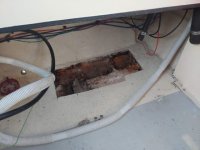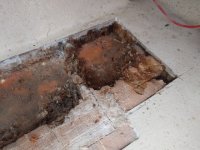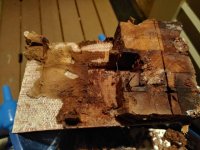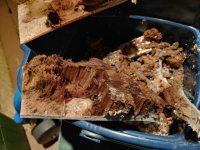My advice, is to use mat which is specifically designed for epoxy. When it is designed for polyester resins, the binder will not wet out/dissolve as well, and the layup will be weaker. The other types of mat will wet out to some degree see below. Again--your boat, your choice.
Mat is a filler and smoother--it is not the structural strength although well wet out mat is used for tabbing in polyester construction. A few boats were built with mostly chopper gun (mat type construction) and did not age well! Cloth and Roving is the strength. Read up in West Systems various tutorials. Learn about the types of material their strengths and uses. In today's world 1708 or equivalent is what is used for the overlay--at least 2 layers. 1708 is biaxial fiber bundles at 45*, there is mat stitched to one side of the layer. This takes the place of 18 oz or 24 oz mat which was used in the past. 1708 is stronger In most applications and easier to work with. 1708 works well with epoxy, since it is stitched.
From Epoxyworks:
Can WEST SYSTEM® epoxy be used to wet out chopped strand mat? The answer is yes. The fiberglass strand in mat wets out with epoxy, but the binder holding things together does not dissolve. (It does get put into suspension and is sealed in the cured epoxy.) This undissolved binder causes the wet-out mat to remain a bit stiff compared to wet out with a styrene-based resin. For gently curving or flat projects like cabin soles or plywood decks, mat and epoxy should work fine. The fabric does not wet out perfectly clear with epoxy. Wet-out clarity of mat with epoxy varies somewhat with different suppliers, but none of them wet out as clear as a good 4 oz or 6 oz fiberglass cloth.
The texture of the chopped strand mat is quite rough given its random fibers (many of which come loose when epoxy is applied). Mat requires a number of coats of epoxy to fill the profile at the surface. 879 Release Fabric can be applied over the freshly wet-out mat to compress the fibers and minimize the need for many of the buildup coats. Using release fabric in this way will result in a much smoother surface, and if you are going to allow the epoxy to cure before continuing, the surface is ready for buildup coats of epoxy or fairing putty after the release fabric is removed.
4 mil plastic sheeting can also be used over the still uncured epoxy and mat to compress the fibers. Trapped air bubbles can be removed by piercing or slitting the plastic over the bubble before the epoxy begins to cure. If the plastic was clean when it was applied, you can pull the plastic after the epoxy cures to a hard gel and apply epoxy fairing putty or buildup coats of epoxy later the same day. If you allow the epoxy to cure hard before pulling the plastic, be sure to sand the surface completely dull before applying more epoxy.
When choosing chopped strand mat to be used with epoxy, look for mat that is soft and pliable. Some forms are quite stiff and may cause problems wetting out with epoxy. Stiff mat is often older stock and the fibers may take more time to wet out with epoxy.
To answer your question about when to stop--go slowly, drill small holes, a short distance from where you last found wet core. Wet core should be replaced--see my comments about freeze thaw cycles. You want only dry core material--I would would not use any material other than Balsa...move methodically thru the boat--checking with percussion and the moisture meter (which may or may not help.
For your work this time of year--you need to be in some type of shelter, I would prefer a shelter which is heated.
West 403: I rarely use this as a thickening agent. It is micro fibers; very short chopped strand and should be used in applications where you want more strength than filling tie bonding agents, and could be used as you lay down on the inner surface of hull's bottom --the strands tend to stick up and then not give as uniform surface, but OK pushed down with the balsa core. If I were bonding two somewhat uneven surfaces, I would use the 403, or a large void--and it could be used on inner parts of the void around the hatches, but I would use 407 near the edge. (Yes, I have all of these fillers in my garage, so I can choose what I need--same for the resins and hardeners).
West 406 Colloidal Silica--Cabosil, Fumed silica--thickening agent.
West 410. Microlight--sanding filler, is easy to sand and contour.
West 404 High density filler
West 407 Low density filler
West 405 Filiting blend
For filling the areas you have pulled the core out of on the hatches, use 406 and 407, you can put a little 403 in if you wish to give a little more strength. I generally use half cabosil with the filler by volume.
Affordable and good for repairs may not equate. Good shops in our area are charging in the $120 plus or minus an hour!!! My good friends who were the best in this area have retired, and I believe they are still doing a few jobs for friends and long term customers for in the $60 to $70 an hour range--but don't have any overhead--and only doing light and relatively short jobs.
I can tell you that "techs" in factories are not earning anywhere near this wage.
I went over the Boatworks videos--for the most part excellent--but for example--in the core video, he is replacing old core with like material--plywood (or in most of the Taiwan boat "mystery wood", as I like to call it. There are certain places where honeycomb core (NadiCore for example) are called for. I have seen hull sides where NadiCore was used. A pilling hit the boat, and there is a very visible indentation where the honeycomb material has been dented. Difficult repair.
He found the center of the flying bridge to be low--because of the poor construction in the first place, and long term deformation caused by water in the core. His solution drill new drain holes.
One other item--he does not wear gloves. This is very foolish--people have toxicity from adsorbed resin and they can become allergic. Always use Nitril gloves. (I used to use latex, and vinyl--but today Nitrile is so much better.)







